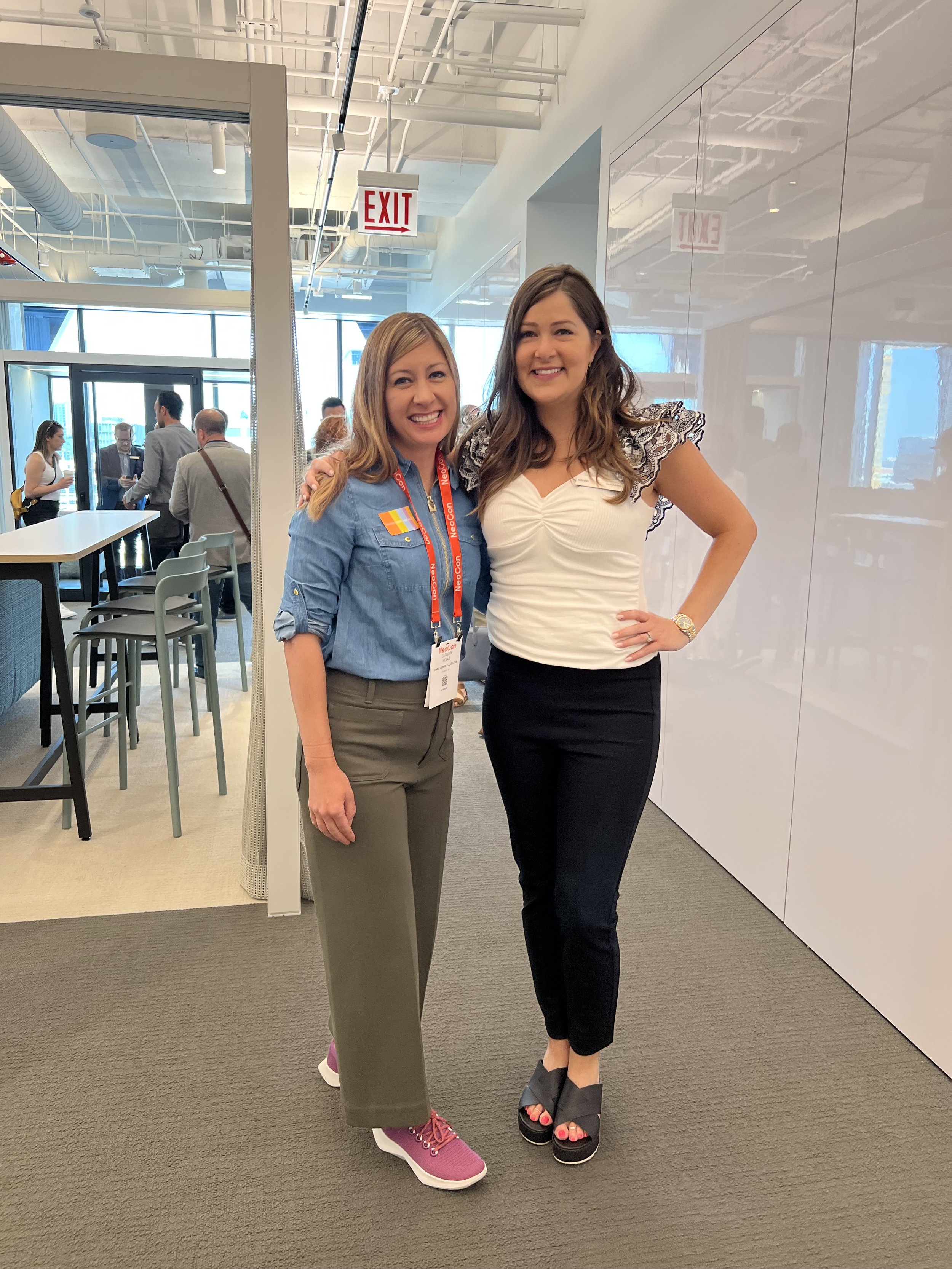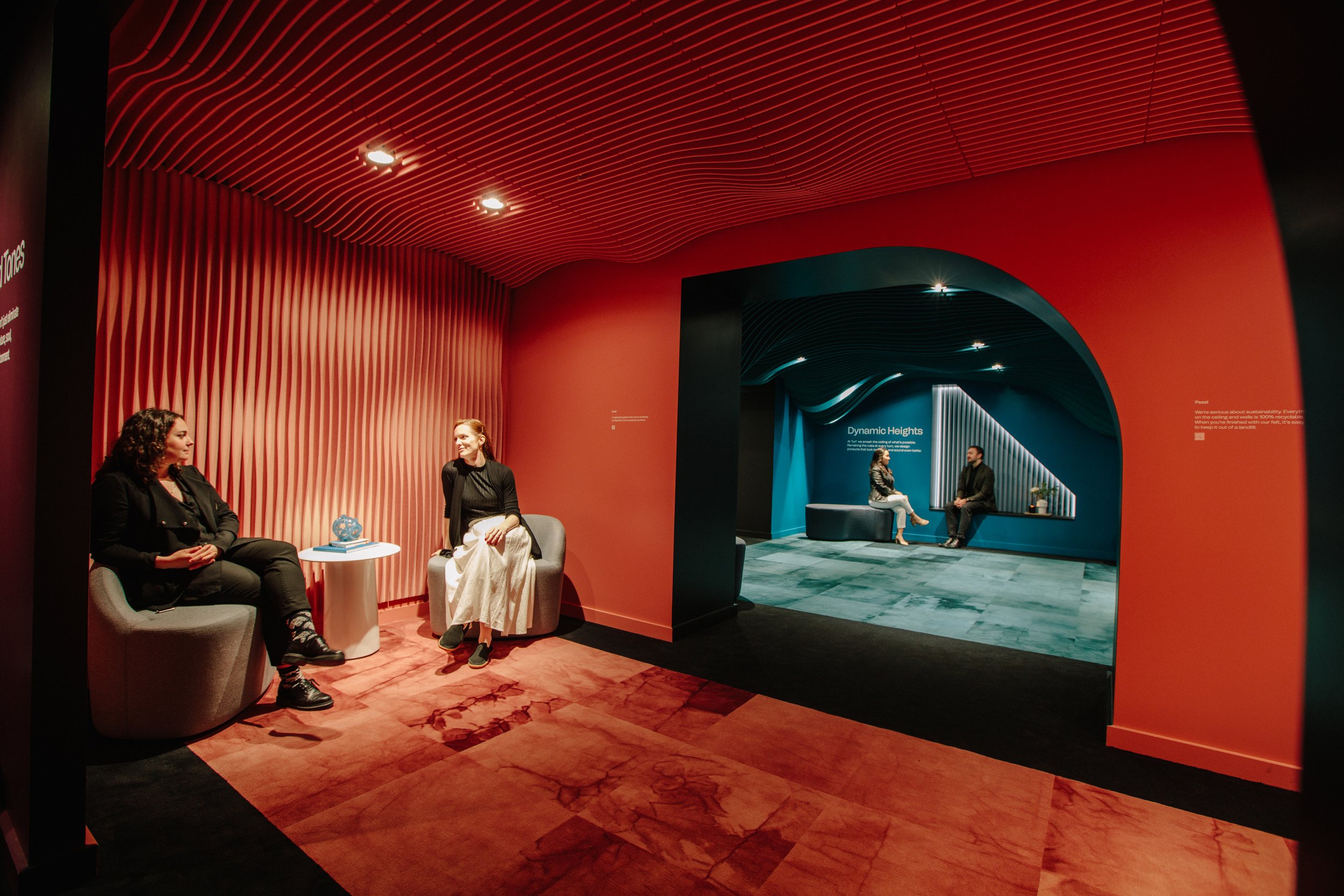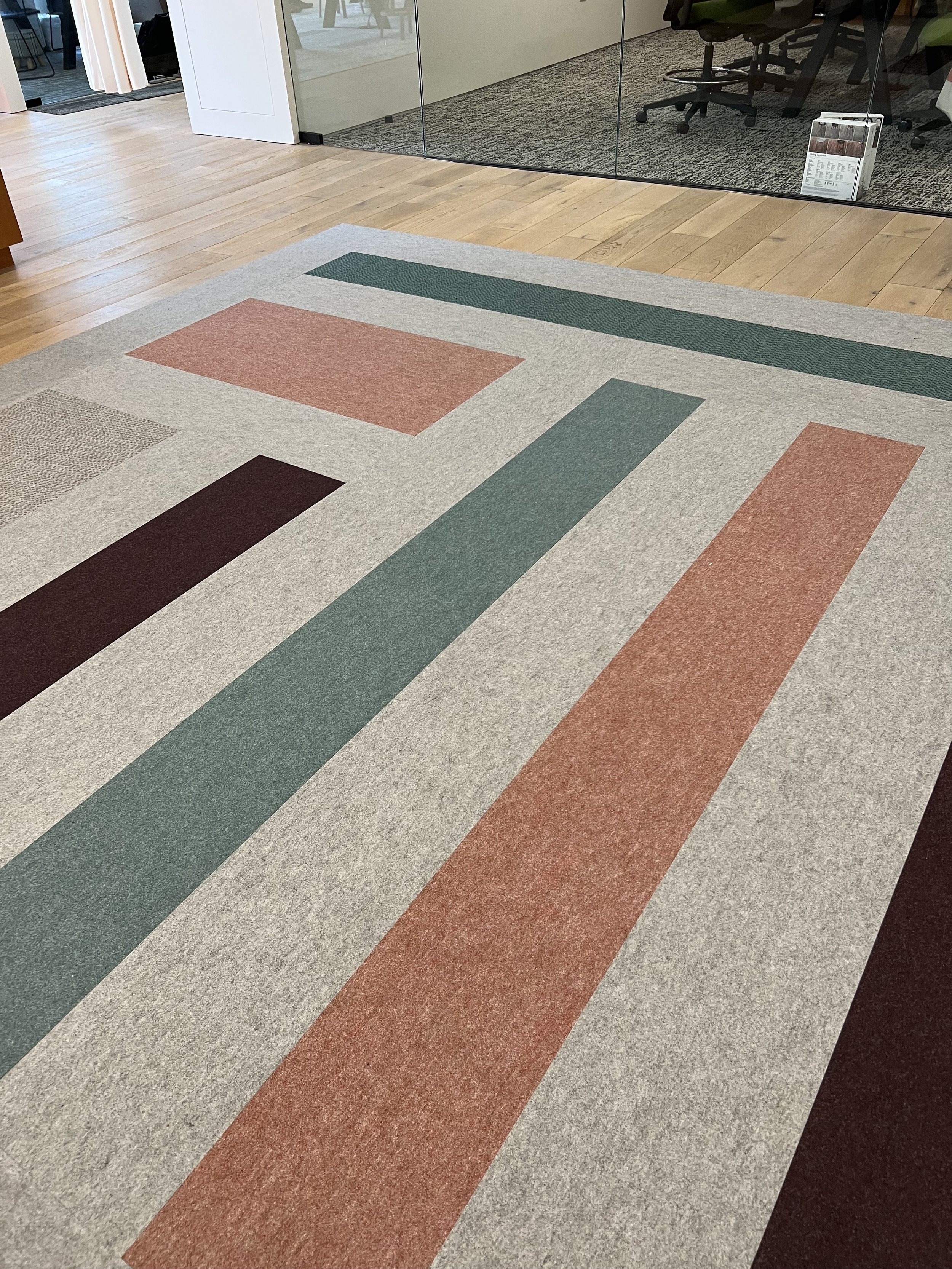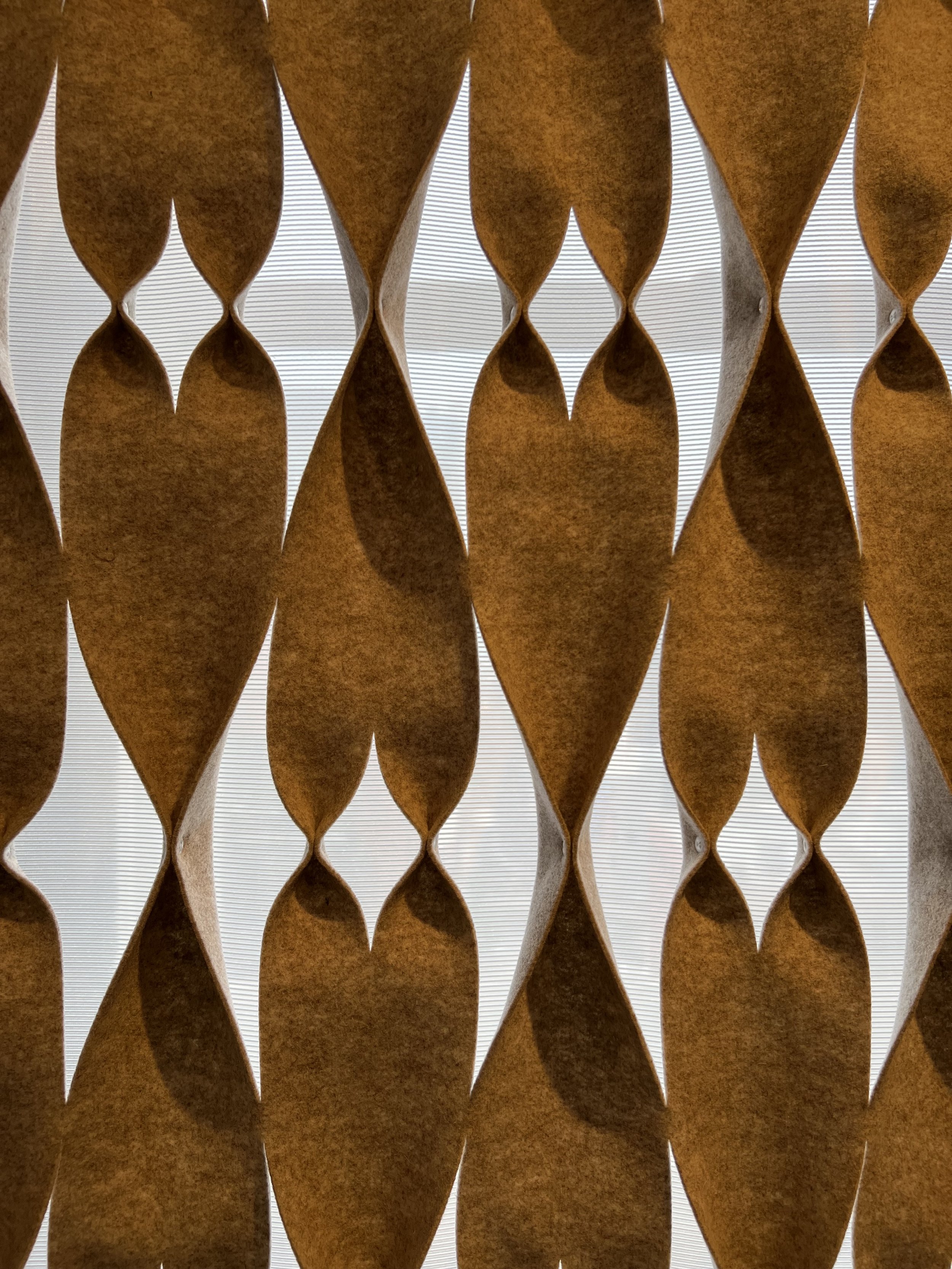// Curated by Carolyn
ADC x Neocon Trending: Color, Material, Form, Finish & Texture
-
Smiles were on full display at Neocon 2022! There’s nothing quite like being immersed in a community of incredible individuals who are on the cutting edge of design. Innovative and wholesome spaces were created through material, product and interior design.
In our most comfortable shoes, we traversed 1 million square feet at the Merchandise Mart, avoided the elevator bank (yes, we took the stairs) and visited the new Fulton Market District, certain themes began to arise. We’ll share with you the themes we saw running through color, material, finish, form, and texture.
-
Colors were optimistic and palettes nuanced. Collections we saw were rooted in science, color theory and color psychology, and were often intentional and feminine. Suzanne Tick was inspired by the ever-expanding universe for her new Fabric of Space collection for LUUM. Vivid coral and pigmented clay were no longer relegated to a decorative touch and utilized in their fullest capacities. Chromatherapy was on full display in showrooms like Kimball and Bernhardt. Experiential and immersive colorscapes were seen at showrooms like Turf.
Materials were sustainable, recycled, repurposed and intentionally designed for human and eco well-being. Finishes were soft and matte. The low sheen aesthetic that is becoming so ubiquitous is haptic and comforting to touch. Textures were biophilic, wood grains, highly tactile, nubby, inviting you to linger, feel comfortable and supported.
Forms were undulating and fluid to build spaces that are cocooning and soothing; or interior offices that are inviting and welcoming. Ergonomics are no longer a talking point, but integrated with subtlety and taste. Negative space celebrated through sustainable fabric at Carnegie that looked like delicate scalloped crepes.
-
There are some trends that follow intellectual and ideological developments in how we as designers approach the spaces we create. We see the lessons we learned from the disruptions in our workspaces over the past years put into practice. The rise of technology supported spaces comes to mind, like Steelcase’s range of products designed intentionally for hybrid work. Their Amobi collection of desk and team products that support an office's computer equipment, while providing a level of flexibility and customization that allows an office to completely tailor their space to personal and team needs. We’ve realized that an office is more than just a place to work– and it’s important to set a stage for workers to experience optimum wellbeing and collaborative energy.
On a similar note, residential design celebrated in office is seeing a wave of support and interest. Elements of home were on display at Shaw Contract with West Elm, and at Teknion - bringing many of our favorite options from our remote workspace into our office workspace. This is further proof that the challenges behind us have us more sensitive to, and capable of addressing, the needs of individuals in our spaces.
The challenges ahead of us got their share of the spotlight as well. From startups to super corporations, we’re seeing teams taking sustainability deeper than ethically sourced materials. For example, Reseat was named as one of Fast Company’s 10 Most Innovative Companies with fewer than 10 employees, Reseat saved more than 3 million pounds of furniture from being sent to the landfill in its first year.
From the broad strokes to the granular details of CMF, It’s clear to see that the design world is moving in a new exciting direction. We have the inspiration and innovation to create spaces that are inclusive, accessible, and supportive to the senses. In a world full of so much change, with the risk of burnout a constant reality for many, creating spaces that nurture is a very real gift that we as designers can give. Here at ADC, we can’t wait to get started.
Designing for a New Era of Travel
duraseinusa.com
-
By Carolyn Ames Noble, Principal, Ames Design Collective, Chair of ASID, WELL Faculty Member
April 2022
No matter where you’re from, if you go back far enough in history, nearly everyone was nomadic. There’s something profoundly human about the need to see new sights and explore the world. So, despite the continued uncertainties we face, it’s no surprise to see travel coming back and in a big way.
Peter Kern, CEO of Expedia Group predicts the summer of 2022 will be the busiest travel season – ever. In February 2022, The World Travel & Tourism Council (WTTC) updated its economic modeling with predictions that U.S. travel and tourism would exceed pre-pandemic levels by 6.2%, accounting for almost $2 trillion in U.S. gross domestic product. Rising costs in gasoline and continued pandemic regulations do not seem to be slowing this overall momentum down.
In the meantime, the status quo has been shaken up, and where there is change, there will always be innovation. There are many different threads weaving into the current landscape of hospitality trends, but sustainability, both in terms of our environment and our mental wellbeing, are an overarching narrative.
ADC has teamed up with our friends at Durasein to investigate and we became fascinated with the following five key hospitality themes.
-
Once considered a late adopter, the hospitality sector will accelerate its drive towards carbon neutrality in 2022 through eco-minded travel experiences.
The ecotourist is primed and ready to take the road untraveled and conscious of carbon footprint. Destinations are reached by rail, electronic powered automobiles, cycling and on foot. Hotels are powered by renewable and natural energy from solar and wind.
Indoor and outdoor spaces are free-flowing, forms are undulating and organic. Foliage and fauna grow unbounded, and natural patterns and water features are present. Gravel paths invite us to wander and explore.
Materials are sustainable, durable, recycled, and purposeful. In spaces like this, minimizing waste is a top priority. Fixing damaged surfaces, as Durasein does with its color-matched adhesives, minimizes footprint. Excess or retired materials can be reclaimed and folded back into the production process to cut impact to an absolute minimum.
Color palettes, materials, and textures champion the outdoors through Biophilic Design. Incorporate wood looks like the Durasein Rooted Collection and earthy looks like Oahu and Volcano
-
What’s the point of traveling if it looks the same as where you started? Radical localism enhances the travel experience by telling the story of a destination, relaying the cultural identity and the site’s specific atmosphere.
Connection to both the community and the self is discovered through immersive and tactile experiences, from weaving to hiking. Our olfactory sense is the sense that is most entrenched with memory. The spirit of place is captured through the use of scent-scaping and fragrance. Hoteliers create a bespoke scent, such as honeysuckle and wild jasmine, that can be replicated long after the travel is complete, harkening a place, a memory, and an experience.
Meals are slow and with intention, and the buzz of conversation emulates through eating spaces. We leave behind our typical tourist shell, trading fanny packs, hats, and cameras for authentic connections to the local community. We eat with new tools, or familiar ones, such as our own hands. We are eager to taste the local cuisine through simple fresh ingredients and spices that satiate our palates.
Our dining experience is an exuberant celebration of family and friends and takes form in easy, curated tabletops. Food is placed on the table or counter surface itself to share and dine. Materials are seamless, highly cleanable and durable, and chemically resistant. This translates to surfaces like walls, too. Colors like Crema Risotto and Outre White resonate with the richness of local flavor.
-
In a world in flux, travel for mental and emotional well-being beckons. We can all appreciate how essential it is to minimize stress in all travel and hospitality settings. And going beyond, designers and hoteliers have an opportunity to create interior environments that are highly tactile, nurturing, and wholesome. This trend is a backlash to the on-screen reality we’ve become accustomed to.
In the first year of the COVID-19 pandemic, the global prevalence of anxiety and depression increased by a massive 25%, according to a scientific brief released by the World Health Organization (WHO). And the ASID 2022 Trends Outlook Report finds parents and caregivers stressed and exhausted as the pandemic drags on, and increasingly weary because of what one parent called the “never-ending rollercoaster” of disruptions to school and childcare services caused by COVID-19.
This trend calls for immersive, quiet, contemplative spaces. Lighting design is an important consideration, including chromotherapy, (also known as color therapy) is the science of using colors to adjust body vibrations to frequencies that are said to result in health and harmony. Chromotherapy has a wonderful place in the shower to promote peace, well-being and healing.
The counterpoint to a quiet retreat, a primal experience like Let it Out Iceland, invites travelers to unleash raw, pent up emotions brought on from the past two + years.
Our pet companions and support animals are no longer relegated to a service only mentality. Hilton reports that of the 23m US homes that welcomed a new pet during the pandemic, two thirds (65%) would prefer to travel with their pet. Google data also shows that searches for dog-friendly staycations are up 143%, while Airbnb reports a significant rise in pet-owners taking their pet on vacation with them.
Conscientious travel is connected to this theme, as there’s no greater luxury than peace of mind - so you can see the importance this narrative echoes in the collective aesthetic sense. Ideal materials and surfaces are clean and translucent, like Outre White. Surfaces are applied throughout the guest suite into the bathroom for a seamless transition from wall to ceiling.Item description
-
Health concerns and shifts in the economy have certainly altered our travel inclinations. The Staycation has become a new art form, and it’s no tragedy. For many of us, the home has become a wonderful escape from the pressures of life— a place tailored to our needs, while offering the backdrop to milestones, celebrations, and connection with community. Investment in the home is flourishing.
The NKBA predicts continued strength in home remodeling in the latest 2022 Home Remodeling Report. And ASID (American Society of Interior Designers) summarizes in its 2022 Trends Outlook Report, rather than emphasize aesthetics or luxuriousness, residential designers should consider marketing their ability to create comfortable, relaxing, and rejuvenating spaces.
For some populations such as families with young children or immunocompromised individuals, the pandemic unfortunately endures. The idea of going away on vacation may pivot to one of creative placemaking at home. Outdoor movies are projected under brightly colored canopies, and meal prep is a shared family experience.
Materials involved need to be durable, easy-to-clean, stain and scratch-resistant, and low in VOCs. We’re drawn to grounded colors like Boardwalk and Concrete, with playful pops of color such as Cheerful Yellow.
-
In all trends there is a counterpoint, and the adventure enthusiast is the opposite of our homebody. Whether forging into the wilderness or walking the streets of a foreign city, the “No Regrets” mindset lives large. This trend seeks to satisfy the senses with the delightful and unfamiliar, with one goal in mind: to leave us reinvigorated.
According to Expedia, 38% of travelers are yearning for travel that elicits excitement and exhilaration. Some of these experiences are sand-dune cruising, glamping under the stars or participating in an immersive 3D art exhibit.
This trend calls you to flex your experimental side with a bold mindset. Forms are geometric and seamless, informed by expressive parametric design like those made by D.Lab x Patternine Parametric Systems. Ideal colors are Arctic White, Glacier Tundra, and Outre White. Item description
-
Whether it's an epic dinner at home or an adventure on an epic journey, spaces that focus on ecotourism, localism, and mental and emotional comfort will offer enhanced travel experiences and bring visitors back for more. Sustainable environments will lead to sustaining experiences, in 2022 and beyond.
Chloe Caemmerer contributed to this article.tem description

Restorative Living: Winter Feature P2, 2022
Restorative Living P2: Movement
January 2022
“WHETHER WE COULD CALL OURSELVES “CREATIVE” OR NOT, WE ARE ALWAYS ALREADY IN THE PROCESS OF CREATING OURSELVES. IT’S AN HONOR AND A GIFT TO BE THE PERSON THAT YOU ARE, AND TO CONTINUE EVOLVING WHO THAT IS EVERY DAY.” - SHANNON REINARD DEMKO.
January 2022
Movement is a core concept from the WELL Building Standard, and perhaps one of the most enigmatic. Circadian lighting, gentle acoustics, and Biophilic materials, for example, can all be absorbed passively. Movement is the concept that really requires us to actively engage in our wellness.
The Northern Hemisphere is in the midst of winter and each day is slowly getting longer.
The WELL Movement Concept promotes movement, physical activity and active living and discourages sedentary behaviors through environmental design strategies, programs and policies. The CDC advises the adults engage in at least 150 minutes of moderate exercise per week. Incorporating exercise throughout the day can help with weight management, improve mood, energy levels, promote healthy sleep habits and boost overall health and vitality.
For some ideas on incorporating movement throughout the day, we reached out to one of our own wellness advisors, Shannon Reinard Demko. Demko is founder of Tashi Collective, a space for virtual & in-person gatherings centered on movement, meditation and open-minded conversation.
CAN: Tell me about Tashi Collective.
SRD: Tashi Collective emerged in 2020, as the yoga studios where I had physically taught began to grapple with the challenges of the pandemic. I wanted to create an online space that would make yoga and meditation accessible to anyone who wanted to join, from wherever they were, without any fuss or pretense. At that time, I was experiencing the huge shift we all were with initial lockdowns, anxiety and uncertainty. I knew from my own experience over decades of practicing that yoga and meditation, with a lighthearted spin, could help a lot of us to manage the strain of simply being alive at this time.
CAN: According to the US Census, more than 13M have two jobs, and that trend is rising since the pandemic began in 2020. Women are more likely than men to have two jobs. Shannon, can you tell us how you balance your roles as a parent, Senior Director & Coach at Management Leadership of Tomorrow and Founder of Tashi Collective?
SRD: This is such an interesting question because I think my answer keeps evolving. My process of “managing” is very flexible, and I think that most people who are successful at this type of balance would say the same. The minute you think you have it all nailed down, something changes, and you need to adapt. One thing I have learned to do is ask for help. So many people balance work and life and family and throw themselves on 100 swords a day they may not need to. Is there someone in your family, your neighborhood, your circle, who could help you with that? Does it ALL need to be done, TODAY, and EXACTLY perfectly? Does it have to be YOU that does it? If so, why? You have to ask yourself how much of what is making you feel stressed is work you assigned yourself that either doesn’t need to be done by you, or to the extent you think it does, or even at all. Free yourself from the idea that things have to be a “certain way,” and just show up for them the way they are. All the truly important things will get done, and you might actually have more fun doing them if you create the space you need to breathe in the midst of it.
CAN: That is so insightful, thank you. Since the pandemic, it is estimated we are now in meetings more than 21.5 hours per week. Echk! How can we effectively build more movement into the busy workday?
SRD: Movement is important for our physical and mental selves, to stimulate creativity, innovation and problem solving.
My first suggestion is to look at how and where you sit, when you do. There are a number of specialized chairs, as well as other alternatives, that can help to support spinal alignment throughout the day. Personally, I sit in front of a window, so that every now and then, I automatically perk up because a bird flew by, or similar natural event, and it wakes me back up to what’s going on in my body.
Second, you don’t always have to sit. One of my favorite ways to take a work call is standing and walking around. If it’s a call where all I need is my brain, I fold laundry or even walk around the block while I’m talking. I personally don’t find it distracting; in fact, the movement keeps my mind more engaged.
If that kind of “multi-tasking” doesn’t work for you, build movement into your schedule. Build in calendar appointments to work out or do yoga. Devices and apps can also help track steps, heart rate or sleep throughout the day.
CAN: You’ve touched on several ways to bring wellness into the interior. Enjoying a view of the outdoors welcomes natural light and principles of Biophilic Design. I am a big fan of walking and talking. Especially for one-on-one meetings where screen sharing is not necessary, I often ask the other person if we can talk via an old school phone call and take a neighborhood loop. An ergonomic chair and sit/stand desk are must-haves whether in your workplace or remote space. For an inexpensive sit/ stand retrofit, try an adjustable laptop stand.
CAN: What poses are best to invoke creativity? What pose can bring a sense of grounding and calm into our day?
SRD: In traditional yoga philosophy, creativity is energetically “housed” in the second chakra, which is right around the hips and lower abdomen. From that perspective, poses that stimulate creativity would be anything that opens the hips, like Half Pigeon or Butterfly, or full front body openers, like Wheel or Bridge poses. I also find that breathwork is really useful for re-engaging creativity.
Grounding energy is also a really important skill, and the wonderful thing is that the techniques we can use for doing so are accessible in almost any circumstance. Place your feet on the floor, or ideally the ground outside. Then, use your physical senses to simply notice what’s around you. What are some things you see, hear, smell, feel? It’s about getting out of the mind, where a lot of stress is manufactured by hypotheticals, and into the reality of the present moment, which is likely far less dangerous than the scenarios the mind can devise when we let anxious energy drive.
CAN: What else should we know?
SRD: I’ve already said a lot! But if there’s one more thing, it would be to remember that you always have the power to change. You can redesign what surrounds you, revise your routines and habits, and redefine yourself – a little bit or completely. Whether we could call ourselves “creative” or not, we are always already in the process of creating ourselves. It’s an honor and a gift to be the person that you are, and to continue evolving who that is every day. Embrace it, including the messes! Don’t the best creations start that way anyway?
We can’t think of better advice. We wish you all a grounded, flexible, and open-hearted winter season– and if you’re in need of a little physical and/or spiritual TLC, head over to tashicollective.com!

